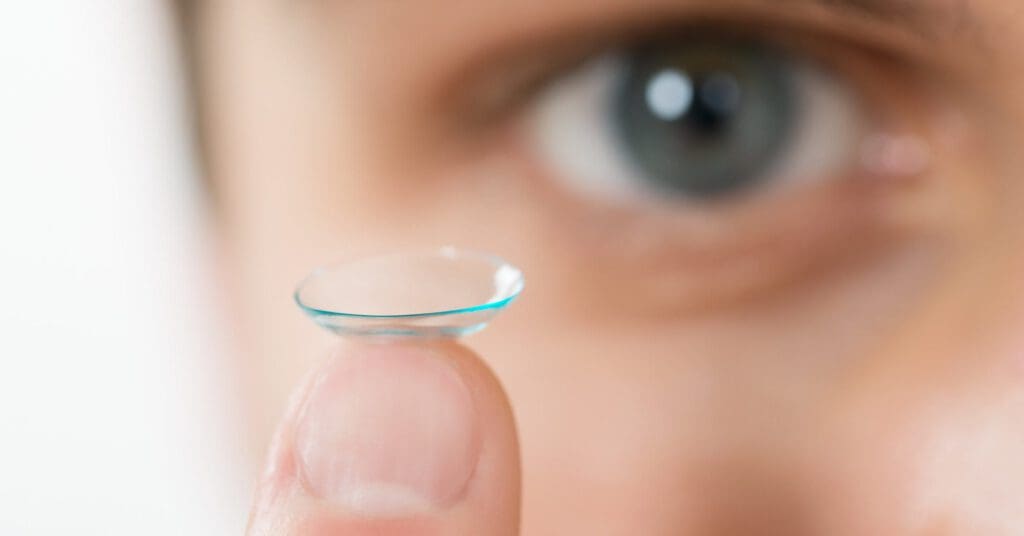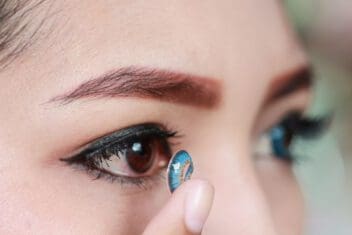Extended Wear Contacts: The Good & The Bad (+ Safety Info)
Home / Understanding Contacts /
Last Updated:
Extended wear contacts are made to stay on your eyes both day and night. For people who want to leave glasses behind, but feel intimidated by surgery or daily contact maintenance routines, they can seem ideal. Some products are cost-effective too.
Extended wear contacts do come with risks, especially if you wear them overnight. Bacteria can build up in the space between the contact and your eye, and that can lead to infections your doctor might struggle to treat.
In the past, extended wear lenses were made exclusively for people with uncomplicated vision issues. Now, they are made for all sorts of eyes. If you have astigmatism, there are extended wear contacts made just for you.
Convenience drives many people to choose extended wear contacts. Skipping cleaning steps can shave precious minutes off a grooming schedule.
But these products are not right for everyone. Your doctor can help you decide if they’ll be helpful tools to help you see clearly.

What Are Extended Wear Contacts?
Extended wear contacts are designed for long-term use. You can wear them during the day, sleep with them at night, and replace them on a schedule dictated by your doctor.
These products are ideal for people who:
You deserve clear vision. We can help.
With 135+ locations and over 2.5 million procedures performed, our board-certified eye surgeons deliver results you can trust.
Your journey to better vision starts here.
- Dislike touching their eyes. Daily wear contacts must be inserted and removed every day. For some people, all of that eye touching is terrifying. With extended wear products, they do not need to tackle these tasks so frequently.
- Constantly run late. Cleaning lenses for daily wear takes just minutes, but for some people, adding even one more step to a hectic schedule leaves them feeling frazzled and worried. Extended wear contacts need less maintenance.
- Want to awaken with clear vision. Wear contacts at night, and you will see clearly as soon as you open your eyes in the morning.
These contacts are made for continuous wear lasting from a week to 30 days, the U.S. Food and Drug Administration reports. Your doctor will tell you how long you can wear the products, and typically, you will give your eyes a rest of at least a night when you’ve worn them as long as you can.
Extended wear contacts are not the most expensive products on the market. That honor goes to daily wear products, reporters say. The longer you wear your products, the more you will save. And since extended wear products do not need daily cleansing, you will also save on solutions and cases.
But in general, experts say, expect to pay between $50 and $70 to fill your prescription for these products.
What Are the Risks of Extended Wear Contacts?
Your eyes rely on a steady stream of tears and plenty of oxygen to stay healthy. Extended wear contacts can prevent one or both of these elements from reaching delicate tissues. When that happens, a host of problems can set in.
Infection is a major concern associated with extended wear contacts. The most common type of infection seen in contact wearers is ulcerative keratitis — a very painful infection that can erode the outer layers of the eye.
The American Academy of Ophthalmology says the risk of this infection is 10 to 15 times higher in people who wear extended contacts, compared to those who wear daily versions.

Sleeping in your contacts increases your infection risk. Taking them out while you sleep, even just once or twice per week, could help to lower your risk.
Contact lens companies say that signs of trouble include:
- Eye discomfort.
- Redness.
- Vision changes.
- Watery eyes.
If you notice these problems, take out your contact lenses, and call your doctor.
You deserve clear vision. We can help.
With 135+ locations and over 2.5 million procedures performed, our board-certified eye surgeons deliver results you can trust.
Your journey to better vision starts here.
Extended Wear Contacts & Astigmatism
People with astigmatism have eyes shaped more like footballs and less like baseballs. The unusual eye shape bends light before it enters the eye, and that can lead to speckles and spots of blurriness.
In the past, people with astigmatism were encouraged to stick with glasses. Doctors can develop lenses made to amend the unusual eye shape, and since the lenses do not move with each blink or eye movement, the correction stays constant. That is not always possible with contacts.
The American Academy of Ophthalmology says that hard lenses tend to work better in people with astigmatism, compared to soft versions. But other options include:
- Toric lenses. These products are weighted, so they tend to stay in place despite blinks and eye movement.
- Gas permeable lenses. These are thick and firm lenses that can push on the eye and amend unusual shapes.
- Hybrid lenses. These combine elements of toric and gas permeable products.
Contact lens developers have created products for astigmatism, and some are made for extended wear. For example, Bausch and Lomb has a product called PureVision 2 that can be work for up to 30 days, and it’s made to alter astigmatism problems.
If you have astigmatism and you’d like an extended wear product, it seems likely that your doctor can find something that would work for you.
Are Extended Wear Contacts Right for Everyone?
Extended wear contacts are not the most popular products on the market. In fact, researchers say that only about 5 percent of new contact fittings are for products like this.
But they are intensely popular among some people with vision problems. And if you care for them properly, they can be an amazing addition to your vision care routine.

If you’d like extended wear contacts, start with a frank discussion with your doctor. Talk about:
- Replacement schedules. How long should you wear your contacts before you toss them for new versions?
- Cleaning routines. How many nights in a row can you wear your contacts? And what should you do with them when they are not in your eyes?
- Hygiene issues. How should you prepare your hands before you touch your contacts or your eyes?
- Signs of problems. How will you know that something is amiss with your contacts? And what should you do if you spot a problem?
After this conversation, you should know how to use these products and protect your eyes. But your doctor may also want to talk with you about suitability. Some people just can’t wear these products.
Extended wear contacts are not recommended for people dealing with:
- Eye infections or inflammation.
- Eye diseases, eye injuries, or dry eye.
- Allergies to contact manufacturing materials.
- Eye medications that interact with contacts.
If these products are not right for you, doctors can help you find an alternative that works better. And if you can’t wear contacts at all, surgery can also deliver crisp vision on the first blink when you wake up. Your doctor might recommend these procedures as viable options.
You deserve clear vision. We can help.
With 135+ locations and over 2.5 million procedures performed, our board-certified eye surgeons deliver results you can trust.
Your journey to better vision starts here.
References
- Types of Contact Lenses. (January 2018). U.S. Food and Drug Administration.
- You Asked: What Type of Contact Lens Should I Wear? (July 2017). Time.
- How Much Do Contacts Cost? (February 2017). Bankrate.
- Extended Wear of Contact Lenses, 2013. (May 2013). American Academy of Ophthalmology.
- Extended Wear: Still an Option? (November 2017). Review of Cornea and Contact Lenses.
- How Long Can You Safely Wear Contacts? Piedmont Healthcare.
- Ultra Contact Lenses Approved for Extended Wear. (May 2018). Review of Optometry.
- Which Is Better for Astigmatism: Glasses or Contacts? (July 2015). American Academy of Ophthalmology.
- Overcoming Astigmatism With Contact Lenses. (May 2017). VSP.
- Contact Lenses for Astigmatism. Bausch and Lomb.
- Important Patient Information Regarding Extended Wear Contact Lenses. (2013). Bausch and Lomb.
This content is for informational purposes only. It may have been reviewed by a licensed physician, but is not intended to serve as a substitute for professional medical advice. Always consult your healthcare provider with any health concerns. For more, read our Privacy Policy and Editorial Policy.
